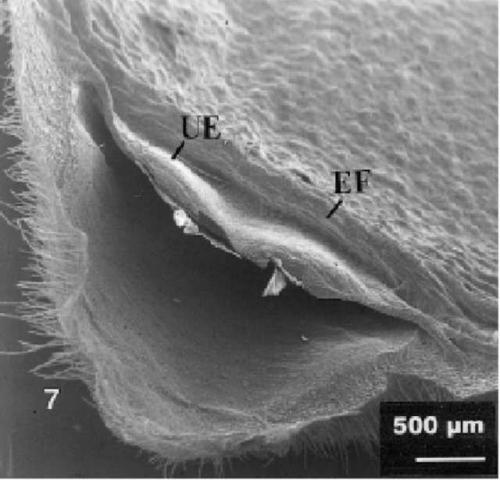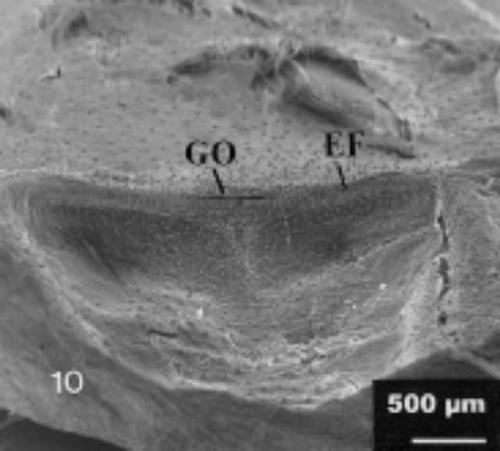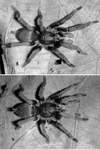Sickius
Genus. Sickius Soares&Camargo, 1948
Genus status. Monotipical genus resurrected by Rogerio Bertani and Pedro Ismael da Silva Jr in 2002 from genus Hapalotremus Simon, 1903 after additional examining of type.
Type and the only species - Sickius longibulbi Soares & Camargo, 1948.
Soares and Camargo in 1948 have described the genus Sickius and its single species Sickius longibulbi Soares & Camargo, 1948, on the base of a specimen of male tarantula, collected at east border of Rio das Mortes, Chavantina, Mato Grosso state, Brazil.
In 1985 Robert Raven synonymized it with genus Hapalotremus Simon, 1903 because it shares the conformation of the tibial spur and the associated bent metatarsus. It is interesting that R. Raven doesn't examining the type and the synonymy was based on the original taxonomic description and published figures. From that time no other study has been done till 2002.
In 2002 Bertani and Silva Jr being search the arachnid collection of Museu de Zoologia da Universidade de Sao Paulo resulted in the rediscovery of the holotype of Sickius longibulbi. Furthermore, collecting in several Brazilian localities resulted in many specimens belonging to genus Sickius allowing to revalidate the genus as well as to describe so far unknown female.
Unexpectedly, this species was found to lack spermathecae, a feature only found in a few spider species (Forster 1980; Uhl 1994) - a primitiv feature not known earlier amongst tarantulas (known only in Liphistiidae, Diguetidae, Archaeidae and some of Pholcidae).
 Herewith, the male semen is stored in the field of uterus internus and not removed from female organism during the molt (amongst all other species of tarantulas (except Xenodendrophila) the semen is stored in spermathecae, a chitin-formed structure, which is attached to the exoskeleton and completely removes with it after the molt (Foelix, 1996).
Herewith, the male semen is stored in the field of uterus internus and not removed from female organism during the molt (amongst all other species of tarantulas (except Xenodendrophila) the semen is stored in spermathecae, a chitin-formed structure, which is attached to the exoskeleton and completely removes with it after the molt (Foelix, 1996).
This genus differs from other representatives of subfamily Ischnocolinae by the characteristic shape of the male palpal bulb and tibial spur as well as by the presence of metatarsal ventral spur (see picture). Female can be distinguished by the absence of spermathecae.
 Characterized with following taxonomical features:
Characterized with following taxonomical features:
absence of stridulatory setae and urticating hairs; cephalic region of carapace very low, hardly distinct; fovea short, shallow, slightly recurved; chelicerae without rastellum, basal segments with 9–10 teeth on promargin; clypeus absent; labium with almost 100 cuspules on its anterior half; tarsi I–IV scopulated, of leg III, IV divided by narrow row of setae; metatarsi I-III scopulate along half their length, metatarsus IV ascopulate; femur IV without retrolateral scopula (female has some different scopula characters); tibia of leg I thickened; male spur with two closely positioned straight branches originating from common, raised base; male palpal bulb keels absent.
General color pattern golden-brown. Carapace, abdomen and legs covered with golden hairs. Leg rings and longitudinal stripes on patellae and tibiae hardly distinct.
In nature lives under rocks and fallen logs, sometimes digging shallow burrows that are filled with silk strands.
Keeping conditions. Any keeping data is absent.
Distribution: known only from the territory of Brazil, where located in Eastern State of Mato Grosso to the Distrito Federal, and south to the States of Mato Grosso do Sul, State of Sao Paulo, and western State of Parana, apparently following gallery forest of the valleys of the rivers Araguaya and Parana as well as the Atlantic semi-deciduous forest of the States of Sao Paulo and Parana.
|
Species |
Common name |
Areal |
Photo |
Biology |
Keeping conditions |
|
longibulbi Soares&Camargo, 1948 |
-
|
Brazil |
By: |
Reaches 2,6 сm in body length (paratype female specimen). Male some smaller |
Do not kept in captivity |
